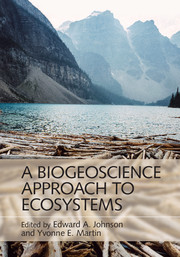Book contents
- Frontmatter
- Contents
- List of contributors
- Preface
- Miscellaneous Frontmatter
- 1 Introduction
- Part I Connecting Ecosystem and Geoscience Processes
- Part II Transport Processes and Conservation Budgets in Biogeoscience
- Part III Coupling Hillslope Geomorphology, Soils, Hydrology, and Ecosystems
- Part IV Coupling Fluvial and Aeolian Geomorphology, Hydrology/Hydraulics, and Ecosystems
- 10 Mechanisms of Flow and Sediment Transport in Fluvial Ecosystems: Physical and Ecological Consequences
- 11 Measuring the Hydraulic Landscapes of Stream-Dwelling Invertebrates for Ecological Research
- 12 Salt Marsh Ecosystems: Tidal Flow, Vegetation, and Carbon Dynamics
- 13 Coastal Dunes and Vegetation Dynamics
- 14 Biogeomorphic Ecosystems within Stressful and Disturbed Environments: A Focus on Termites and Pioneer Plants
- Index
- References
13 - Coastal Dunes and Vegetation Dynamics
from Part IV - Coupling Fluvial and Aeolian Geomorphology, Hydrology/Hydraulics, and Ecosystems
Published online by Cambridge University Press: 27 October 2016
- Frontmatter
- Contents
- List of contributors
- Preface
- Miscellaneous Frontmatter
- 1 Introduction
- Part I Connecting Ecosystem and Geoscience Processes
- Part II Transport Processes and Conservation Budgets in Biogeoscience
- Part III Coupling Hillslope Geomorphology, Soils, Hydrology, and Ecosystems
- Part IV Coupling Fluvial and Aeolian Geomorphology, Hydrology/Hydraulics, and Ecosystems
- 10 Mechanisms of Flow and Sediment Transport in Fluvial Ecosystems: Physical and Ecological Consequences
- 11 Measuring the Hydraulic Landscapes of Stream-Dwelling Invertebrates for Ecological Research
- 12 Salt Marsh Ecosystems: Tidal Flow, Vegetation, and Carbon Dynamics
- 13 Coastal Dunes and Vegetation Dynamics
- 14 Biogeomorphic Ecosystems within Stressful and Disturbed Environments: A Focus on Termites and Pioneer Plants
- Index
- References
Summary
Sand Dunes are great fun.
(Greely and Iverson, 1984)Introduction
The dynamic nature of sand dunes over relatively short spatial and temporal scales makes them an ideal phenomenon from which to obtain a better understanding of the interactions between the geosciences and biological sciences. Most early studies of sand dunes focused on classification of dune forms, plant species composition on various dune types, plant succession, and the morphological adaptation of plants to sand burial, salt spray, and xeric conditions. In this chapter, the interaction of ecology and geomorphology in the development of coastal sand dunes will be discussed, from the origin of ecology in the 1800s through to the present. Underlying this history is a struggle by both disciplines to move from a mainly descriptive approach toward an understanding of how sand dunes and plants influence each other. The difficulty has always been how to couple the physical processes of sand transport with the influence of plants and, in turn, how to connect plants with different life histories to sand transport. This undertaking is still in its infancy.
Physiography and Physiographic Ecology
At the end of the 1800s, both physiography (as geomorphology was called at the time) and biology adopted a neo-Lamarckian evolutionary viewpoint (Johnson, 1979; Inkpen and Collier, 2007). Evolution, at this time, incorporated ideas of directional development that could take place at scales above the individual or population (today this idea is called group selection and is mostly rejected as having no valid mechanism (Williams, 1966)). Stages in this directional development were believed to facilitate further evolution. The result was a belief that many forms in biology developed in a progressive, integrated manner with an end-stage that would be in equilibrium. Herbert Spencer, a prolific but now largely forgotten philosopher, was a popular exponent of these ideas, combining both “evolutionary” and “quasi-thermodynamic” ideas in Principles of Biology (1864). He is best remembered for the teleological term “survival of the fittest.”
These evolutionary viewpoints can be found in numerous scientific studies, such as the landscape cycles of Davis (1889; 1899) and in the ecology of communities and succession of Cowles (1899), Clements (1916), and Cooper (1926).
- Type
- Chapter
- Information
- A Biogeoscience Approach to Ecosystems , pp. 435 - 455Publisher: Cambridge University PressPrint publication year: 2016



